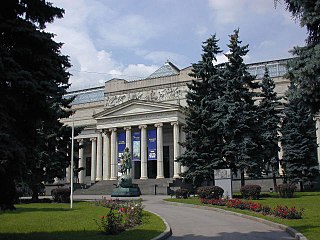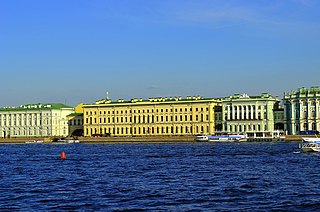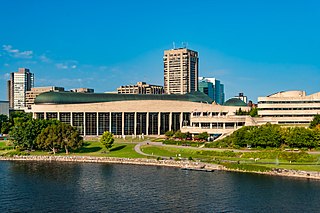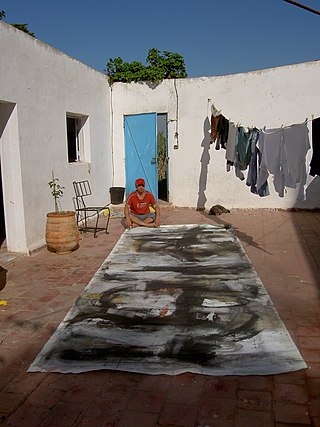
The Pushkin State Museum of Fine Arts is the largest museum of European art in Moscow. located in Volkhonka street, just opposite the Cathedral of Christ the Saviour. The International musical festival Sviatoslav Richter's December nights has been held in the Pushkin Museum since 1981.

The State Hermitage Museum is a museum of art and culture in Saint Petersburg, Russia. It was founded in 1764 when Empress Catherine the Great acquired a collection of paintings from the Berlin merchant Johann Ernst Gotzkowsky. The museum celebrates the anniversary of its founding each year on 7 December, Saint Catherine's Day. It has been open to the public since 1852. The Art Newspaper ranked the museum 10th in their list of the most visited art museums, with 2,812,913 visitors in 2022.

The Canadian Museum of History is a national museum on anthropology, Canadian history, cultural studies, and ethnology in Gatineau, Quebec, Canada. The purpose of the museum is to promote the heritage of Canada, as well as support related research. The museum is based in a 75,000-square-metre-building (810,000 sq ft) designed by Douglas Cardinal.

Andrei Rublev was a Russian icon painter. He is considered to be one of the greatest medieval Russian painters of Orthodox Christian icons and frescos.

The Virgin of Vladimir, also known as Vladimir Mother of God, Our Lady of Vladimir, and the Theotokos of Vladimir, is a 12th-century Byzantine icon depicting the Virgin and Child and an early example of the Eleusa iconographic type. It is one of the most culturally significant and celebrated pieces of art in Russian history. Many consider it a national palladium with several miracles of historical importance to Russia being attributed to the icon. Following its near destruction in the thirteenth century, the work has been restored at least five times.

The State Tretyakov Gallery is an art gallery in Moscow, Russia, which is considered the foremost depository of Russian fine art in the world.

The Moscow Museum of Modern Art is a museum of modern and contemporary art located in Moscow, Russia. It was opened to public in December 1999. The project of the museum was initiated and executed by Zurab Tsereteli, president of the Russian Academy of Arts. In 2018, The Vadim Sidur Museum and Museum-Studio of Dmitry Nalbandyan merged into the Moscow Museum of Modern Arts.

The use and making of icons entered Kievan Rus' following its conversion to Orthodox Christianity in AD 988. As a general rule, these icons strictly followed models and formulas hallowed by Byzantine art, led from the capital in Constantinople. As time passed, the Russians widened the vocabulary of types and styles far beyond anything found elsewhere in the Orthodox world.

Pyotr Dmitrievich Baranovsky was a Russian architect, preservationist and restorator who reconstructed many ancient buildings in the Soviet Union. He is credited with saving Saint Basil's Cathedral from destruction in the early 1930s, founding and managing the Kolomenskoye and Andrei Rublev museums, and developing modern restoration technologies.

The Anchorage Museum is a large art, history, ethnography, ecology and science museum located in a modern building in the heart of Anchorage, Alaska. It is dedicated to studying and exploring the land, peoples, art and history of Alaska.

The Evansville Museum of Arts, History & Science is a general-interest museum located on the Ohio riverfront in downtown Evansville, Indiana, United States. Founded in 1904, it is one of Southern Indiana's most established and significant cultural institutions, with comprehensive collections in art, history, anthropology and science. It has a permanent collection of over 30,000 objects including fine arts, decorative arts, historic documents and photographs, and anthropologic and natural history artifacts. Also on the museum's campus is the Evansville Museum Transportation Center, featuring Southern Indiana transportation artifacts from the late 19th through the mid-20th centuries. The museum is accredited by the American Alliance of Museums.

The Trinity is an icon created by Russian painter Andrei Rublev in the early 15th century. It is his most famous work and the most famous of all Russian icons, and it is regarded as one of the highest achievements of Russian art. Scholars believe that it is one of only two works of art that can be attributed to Rublev with any sort of certainty.

Sergei Ivanovich Shchukin was a Russian businessman who became an art collector, mainly of French Impressionist and Post-Impressionist art.

The Lumiere Brothers Center for Photography is a private exhibition organization located in the former chocolate factory and acting art cluster Red October in Moscow.

Roland Shalamberidze (born 11 January 1958, is a contemporary Russian artist of Georgian origin.

The Museum of Russian Icons is the first in Moscow and the second in Russia private collection of the works of the Old Russian art.

Natalia Eduardovna Grigorieva-Litvinskaya is a founder and Chief Curator of The Lumiere Gallery (2001) – the first Russian photography gallery, aimed at encouraging promotion and sales of the finest Russian and European photographs in Moscow.

The Lamont Gallery is a non-profit art gallery located on the campus of Phillips Exeter Academy, in Exeter, New Hampshire, United States. It primarily showcases visiting exhibitions of local, national and international acclaimed artists, along with art of Phillips Exeter students and faculty. However, it also possesses a small collection.

The Church of St. Nicholas in Tolmachi is both a Russian Orthodox house church and museum that is part of the State Tretyakov Gallery located in Moscow. The church is home to several religious relics and icons, including the culturally important Our Lady of Vladimir.

Zelfira Ismailovna Tregulova is a Russian art historian and curator who served as a director of the Tretyakov Gallery in Moscow between 2015 and 2023.




















